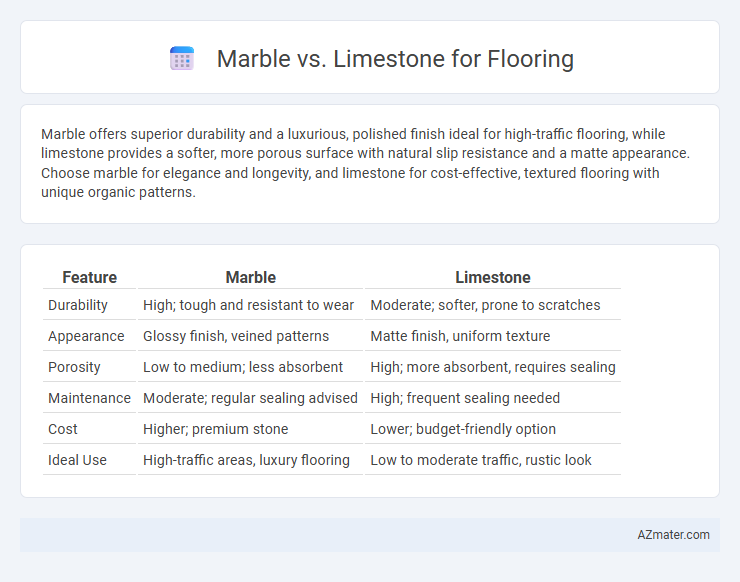Marble offers superior durability and a luxurious, polished finish ideal for high-traffic flooring, while limestone provides a softer, more porous surface with natural slip resistance and a matte appearance. Choose marble for elegance and longevity, and limestone for cost-effective, textured flooring with unique organic patterns.
Table of Comparison
| Feature | Marble | Limestone |
|---|---|---|
| Durability | High; tough and resistant to wear | Moderate; softer, prone to scratches |
| Appearance | Glossy finish, veined patterns | Matte finish, uniform texture |
| Porosity | Low to medium; less absorbent | High; more absorbent, requires sealing |
| Maintenance | Moderate; regular sealing advised | High; frequent sealing needed |
| Cost | Higher; premium stone | Lower; budget-friendly option |
| Ideal Use | High-traffic areas, luxury flooring | Low to moderate traffic, rustic look |
Introduction to Marble vs Limestone Flooring
Marble flooring offers a luxurious, polished surface with natural veining, providing a high-end aesthetic ideal for formal spaces. Limestone flooring features a softer, matte finish that adds warmth and a subtle texture, suitable for rustic or casual interiors. Both materials are durable natural stones but differ in porosity and maintenance requirements, influencing their suitability for various environments.
Key Differences Between Marble and Limestone
Marble flooring offers a polished, luxurious appearance with higher durability and resistance to scratches compared to limestone, which is softer and more porous, making it prone to stains and wear. Marble's crystalline structure provides a reflective sheen and a variety of veining patterns, whereas limestone displays a more matte finish with subtle, earthy tones and uniform texture. Maintenance for marble requires regular sealing to preserve its luster, while limestone needs frequent sealing and gentle cleaning to avoid damage from acids or abrasive materials.
Appearance and Color Variations
Marble flooring is renowned for its elegant, luxurious appearance with distinctive veining patterns that create a dynamic visual appeal, available in a wide range of colors from white and black to green and pink. Limestone offers a more subtle, matte finish with earthy tones such as beige, tan, and gray, providing a natural, rustic charm that complements traditional and contemporary designs. Both materials feature unique color variations influenced by mineral content, but marble tends to display more dramatic contrasts and glossy surfaces ideal for upscale interiors.
Durability and Longevity Comparison
Marble flooring offers superior durability with its dense, hard surface that withstands heavy foot traffic and resists scratches better than limestone. Limestone, although aesthetically pleasing and softer with a warm texture, is more porous and prone to erosion, making it less resilient over time. For long-term flooring solutions, marble provides enhanced longevity, maintaining its polished finish and structural integrity for decades with proper maintenance.
Maintenance and Cleaning Requirements
Marble flooring demands regular sealing and delicate cleaning with pH-neutral products to prevent etching and staining due to its porous nature. Limestone requires gentle cleaning methods and consistent sealing to avoid damage from acids and moisture, as it is more susceptible to scratching and discoloration. Both materials benefit from prompt spill cleanup and routine maintenance to preserve their natural beauty and durability.
Slip Resistance and Safety Factors
Marble offers a polished surface that can be highly slippery when wet, posing safety concerns in high-traffic or moisture-prone areas, whereas limestone typically has a naturally textured, matte finish that provides better slip resistance. The durability of limestone under foot traffic and its porous nature allows for the application of anti-slip treatments, enhancing safety without compromising aesthetic appeal. Choosing limestone for flooring prioritizes slip resistance and reduces the risk of slips and falls, making it a safer option over slick marble in environments where safety is a critical factor.
Cost Comparison: Marble vs Limestone
Marble flooring typically costs between $10 to $20 per square foot, making it a more expensive option compared to limestone, which ranges from $5 to $15 per square foot. The installation costs for marble are higher due to its density and weight, requiring specialized labor and tools. Limestone offers a budget-friendly alternative with easier installation and maintenance, which can significantly reduce overall flooring expenses.
Installation Process for Both Materials
Marble flooring requires careful handling due to its natural veining and susceptibility to scratching, with installation involving precise cutting, leveling, and the use of a slurry or thin-set mortar to secure tiles. Limestone installation follows a similar procedure but demands extra caution against moisture absorption, often necessitating sealing before and after laying to protect the porous surface. Both materials benefit from professional installation to ensure longevity, seamless joints, and an even surface, with marble generally requiring more skilled labor due to its density and brittleness.
Best Applications and Room Recommendations
Marble flooring excels in areas requiring high elegance and durability, such as entryways, living rooms, and bathrooms, due to its polished finish and resistance to moisture. Limestone offers a softer, more textured surface ideal for casual spaces like kitchens and outdoor patios, where slip resistance and a warmer aesthetic are beneficial. Both materials thrive in indoor settings but differ in maintenance; marble demands regular sealing to prevent staining, while limestone is more porous and suited for low-traffic zones.
Pros and Cons of Marble and Limestone Flooring
Marble flooring offers a luxurious, elegant appearance with high durability and resistance to heat, but it requires regular sealing and can be prone to scratching and staining. Limestone provides a softer, more natural look with excellent slip resistance and affordability, yet it is more porous, making it susceptible to moisture damage and staining without proper maintenance. Both materials demand careful upkeep, but marble suits high-traffic, upscale spaces, while limestone fits casual, rustic environments better.

Infographic: Marble vs Limestone for Flooring
 azmater.com
azmater.com